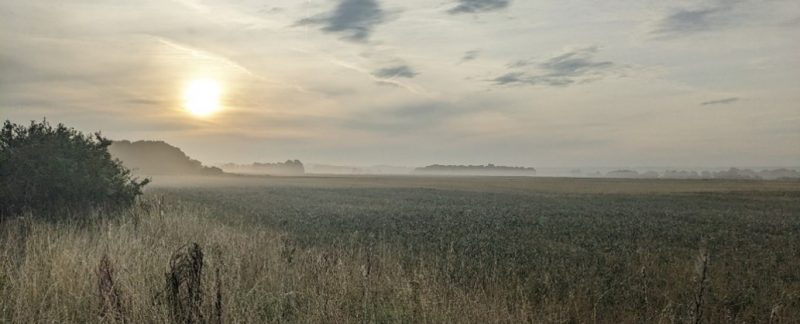Wednesday 30 August
Recces
Ryan arrived at the Horseshoe Lagoon at 05:30 with high tide at 06:26 and immediately recorded seven Oystercatchers, 12 Bar-tailed Godwit, five Dunlin, two Grey Plover and 150 mixed gulls. At 05:48, the Barwits, Dunlin and Grey Plover left heading north and at 06:07, 70 more gulls joined the roost. Elsewhere on the pool there were 30 Redshank, two Grey Plover, 11 Little Egret and six Greenshank. It was clear that the pool needed more water as Black-headed Gulls could stand almost all the way across from normal catch site to the island.
Richard observed a small number of plovers at the Gedney pool when they arrived. It filled about 25 minutes before tide.
At Heacham North North, Cathy recorded 10 Turnstone and 10 Sanderling at high tide.
Flo noted that the Ringed Plover fencing was still up at Heacham South. At 5:50, 120 Sanderling and <20 Turnstone were just beyond the first fenced area, but they soon moved in front of the fencing. By 06:00 there were 90–110 Sanderling and a couple of Ringed Plover and Turnstone at the end of the houses. By 06:20, this flock had increased to 150 and moved further away from the housing. There was a flock of c. 300 Sanderling, 20 Turnstone and a few Ringed Plovers just before the next set of fencing, but this was dispersed by a Peregrine at 06:24. Fifty Sanderling returned to the same spot, some went to the flock near the end of the housing, and the rest then left.
At Snettisham, Tim observed 300 Sanderling by the carpark at 05:50. There was a scattering of birds through the fencing, Snettisham side of the dam. He saw 50 Knot close to the fencing area, but they were not staying put. Post tide, some birds gathered in the front of the middle of the fenced area – around 100 Sanderling and a few Turnstone. It was very gusty, 15–20 mph with 1–2 feet of wave action.
Catching attempt
Both teams aimed to arrive at the base house in the early afternoon. The plan was to try and catch Curlew at Terrington Marsh. The strimming and marking team (Richard, David K, Tim and Emily) left at 14:00, with the rest of the team (Ryan, Flo, Lucy C, Lucy Y, James R, Sabine, Nigel, Jacquie, Steve, Christine, Claudia ad Alex R) leaving at 14:45 to help set and be in position by 17:00 (dinner was had at 16:30).
Despite best efforts the catch was called off after a harrier caused disturbance, with the aim to try again in the morning. Rob R, Alex D and Chantal arrived later in the evening.
Thursday 31 August
Catching attempt
With high tide at 07:11, the team were up at 04:30 to get in position by 05:30 to cannon net on Terrington Marsh – manning the set from the previous night. Lucy led the catch. There were birds moving about when the marsh team got into position. Flocks of birds landed in their preferred spot and then everyone waited for the tide to rise. Alex went out to give the marsh team sacks but then the birds started moving which caused some to land in the catching area. Approximately 18 could be fired on and they waited to see if any more would come down, however there was no other movement. Once the birds decided to get twitchy, it was decided to take the catch, as the priority was to get tags deployed on Curlew.
The team successfully caught one Whimbrel and 10 Curlew, of which all the new Curlew were colour-ringed and five were fitted with tags to look at the movements of Curlew and their use of fields and marsh. The tagging group were separate from the processing team to minimise stress.
The retrapped Curlew, ringed by Harry Ewing and Nigel in 2021, was a Breckland (Honington) breeder and had only ever been reported at that site.
| Species | New | Retrap | Total |
| Curlew | 9 | 1 | 10 |
| Whimbrel | 1 | 0 | 1 |
| Totals | 10 | 1 | 11 |
Taking the kit off the marsh at high tide was an interesting challenge with two ‘guardians of the planks’ marking the best area to cross the now submerged ditches and keeping the bridge from floating away! Some people weren’t successful and got a ‘bit’ wet!
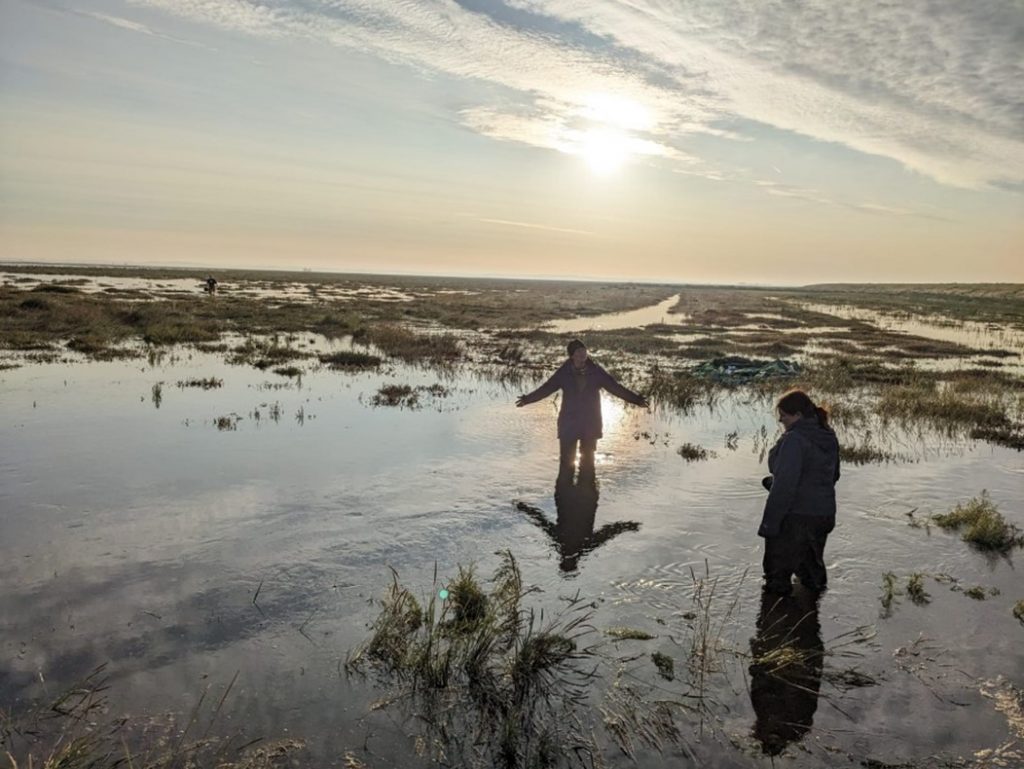
Recces
Richard had 1,500 birds at Gedney which looked like a viable option for the evening. There were two fields with Curlew nearby which were potentially catchable. One was big cabbage with stubble mess nearby while the other was bare.
At Holbeach there was nothing on the fields with a lot of birds still on the marsh at high tide.
Tim, Daphne and Manu observed good numbers of Sanderling at Heacham South. They noted that the beach profile had a bit of a dip but was doable.
Heacham North North had approximately 10–20 Turnstone.
At Snettisham, Dave had Sanderling immediately straight out. There was fair scattering of Ringed Plover and 40 Sanderling and north of the dam, there was a flock of 80 Sanderling along with odds/sods.
Steve and Will were at Horseshoe Lagoon which had a few birds including some Greenshank but nothing on the fields.
After processing and recces were finished, the team regrouped at the Norfolk base and had breakfast, thanks to Ryan, Kirsty, Sabine and Manu!
Catching attempt
It was decided that after the promising recce at Gedney, we would aim to cannon net there that afternoon/evening (high tide at 19:45). The setting team left at 13:30 with the those making dinner to arrive at 16:00. A quick dinner was had (thanks Alex, Chantal, Sam and Christine) before everyone got into position with two marsh base camps. As this was going to be a wet catch, the aim of the forward one, being the nearest to the nets, was to get there fast while the rearward marsh base camp would make sure to quickly bring the boxes to the net to speed up extraction of birds.
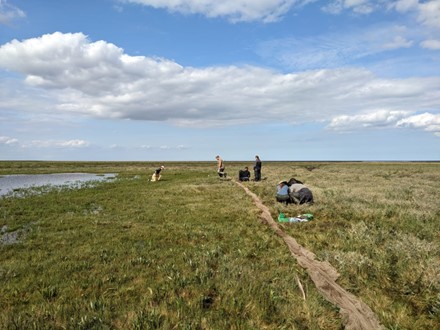
At 18:30, the team took a good catch of waders which was the first really successful cannon net catch on Gedney! Five of the Bar-tailed Godwits were also fitted with tags while all the Knot were flagged.
| Species | New | Retrap | Total |
| Redshank | 3 | 0 | 3 |
| Bar-tailed Godwit | 15 | 0 | 15 |
| Black-tailed Godwit | 2 | 0 | 2 |
| Dunlin | 65 | 1 | 66 |
| Knot | 41 | 0 | 41 |
| Grey Plover | 53 | 2 | 55 |
| Totals | 179 | 3 | 182 |
Initially the plan was that a small team would leave Gedney to set at Heacham South in advance of the morning’s high tide. Due to access issues (thanks to Dave who had gone to recce) and the fact that it had been a good catch at Gedney, this was changed with the aim to catch at Heacham North and therefore set in the morning.
Friday 1 September
Catching attempt
The team were up at 05:30 to be at Heacham North North by 06:45. With high tide at 07:53, the net was set in front of the marram grass. It was initially set with half jumps and there was effort made to twinkle, but the birds were uncooperative. The jump ropes were then lengthened but the birds still didn’t go into the catching area and, as the tide was now receding, the birds were preferring to be at the freshly exposed ridge. We moved the net down onto the ridge and with four people twinkling to get the birds into the catching area and prevent them from moving behind the closest twinklers, we were able to take a catch. The lift went well and we colour ringed most of the adult, moulting Turnstone. Dave B did a great job with the HPAI protocol cleaning the boxes and kit.
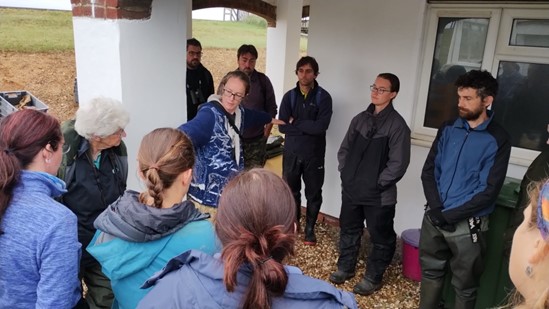
| Species | New | Retrap | Total |
| Turnstone | 56 | 5 | 61 |
| Sanderling | 27 | 2 | 29 |
| Ringed Plover | 2 | 1 | 3 |
| Totals | 85 | 8 | 93 |
After the trip, Richard had a quick look at BTO data on previous catches of Turnstone and the last time there was a catch over 50 at WWRG was in 2003!
Recces
Rob R went to Gedney where there were few birds were moving about. There were 200 Little Egrets but nothing on the Greenshank pool. He then went to Holbeach and found two large flocks of 700 and 1,500 Curlew and Godwit on stubble fields.
On Terrington Marsh, Richard observed 600 Curlew with two headstarted birds. He also checked the Terrington fields and found two headstarted Curlew on the seawall.
On the Lincolnshire side, the Horseshoe lagoon had 50 Redshank. There were fewer birds there because of wildfowling. Although there were Curlew on the field at the Friskney control tower, the presence of the wildfowler was a concern as the birds might be disturbed from there. Bowser’s unharvested potato field which had birds was unsuitable due to the troughs.
Nigel went to Sandringham and watched the tide come up. At the northern fields, he found a field with 600–700 Greylag geese, 1,000+ gulls, 1,500 Curlew and 1,500 Godwits.
Setting
Back at the base, there were several jobs including making up more cartridges. Given information from the recces, it was decided to set six nets on the field at Sandringham with two clap-net pairs on one side of the field and one clap-net pair on the other. The majority of the team went to set and were on site by 15:00 and finished by 18:00. Upon everyone’s return, dinner was had at 19:30 – thanks to Alex, Lucy and Christine who made it!
Saturday 2September
Catching attempt
The hide and far base teams were up at 04:45 allowing for everyone to get into position and have decoys out before the near base team arrived at 06:30. Forty minutes before high tide, some juvenile Curlew and Godwit landed in the with decoys. When the large flocks came in, they landed across the four nets. One headstarted Curlew landed in Steve’s net. From the hide, they estimated 400 Curlew and between 200–300 Godwit in the catching area but with no possibility of firing as birds were too close to the nets. A comment across the radio was that the ‘march of the Godwit into the catching area was quite impressive.’
Unfortunately, a decoy fell over and acted like a scarecrow and the birds started moving away from the catching area. Despite efforts to get the birds to go into Richard’s side of the clap net, jiggling caused the birds to lift and land close to the hide. There were 20 Bar-tailed Godwits and three Curlew in Steve’s net however it was decided to attempt a catch the following day, so we did not catch them. Geese and raptors were the other disturbances affecting the waders.
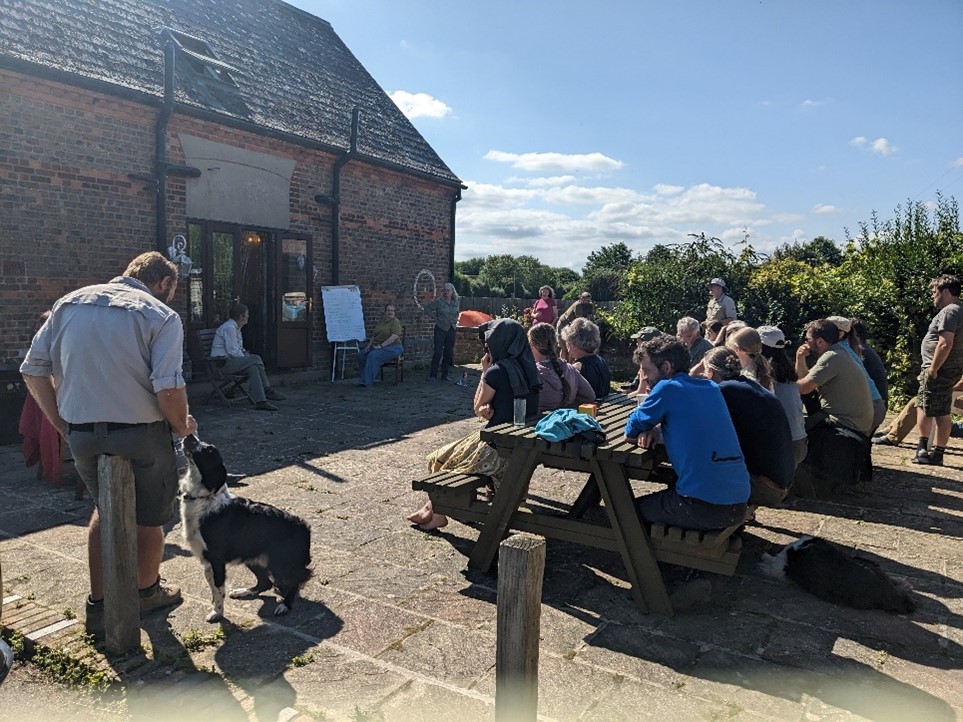
Maintenance
Upon return to the base, we all had breakfast (led by Cathy!) and the afternoon was spent on maintenance with a full white board of things to do (including making more colour rings)! One task included felling the tree in the driveway which will make space for more cars in the future. There was then a queue for some free firewood.
Resighting
Two teams also went out to do some resighting leaving at 16:00 with one going to Heacham North North (Claudia, Alex R, Luke and Hilary) and the other going to Snettisham (Cathy, Sabine and Manu). In the evening we had toad in the hole thanks to Will and sous chefs!
Sunday 3 September
Catching attempt
Times were the same as the previous morning with both hides and basecamps in position by 06:30. It was a slower start in comparison to the previous morning with some fog and fewer waders flying inland over the field, although large flocks could be seen on the other side of the seawall near Snettisham.
Cars were deployed to determine if there were any Curlew in nearby fields that could be twinkled. Approximately 1,200 Curlew and Godwits were found by Michele, Luke and Manu in a field a little bit south of the catching field while Christine’s car also found them. Unfortunately, the majority of these birds went over the saltmarsh, but there were waders that had landed in the catching area and a catch was taken. The Curlew were flagged and there was one which shared its initials with Nigel!
| Species | New | Retrap | Total |
| Curlew | 30 | 9 | 39 |
| Totals | 30 | 9 | 39 |
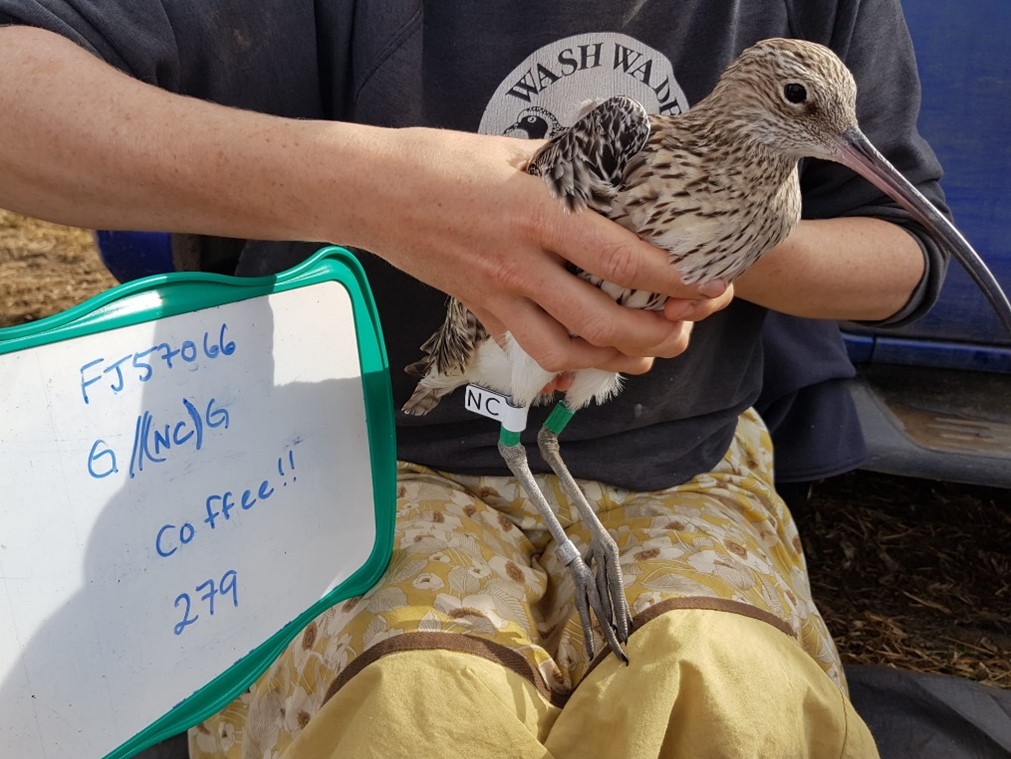
Recce & resightings
Sabine investigated the first site at Holbeach which had 200+ Curlew present while the second stubble site had 500+ Curlew.
Rob R had some birds present on the Horseshoe Lagoons.
Rob P was at Frampton resighting Knot, while Hilary was at Frieston and observed 1,500 Oystercatchers, 20 Turnstone and 800 Redshank (one marked ALJ).
Back at the base, we had a good breakfast (thanks to Alex D, Lucy C, Will and Ryan for making it) and then the plan for the evening and subsequent morning was discussed. We decided to mist net at Terrington White Barn in the evening and then cannon net at the two Holbeach sites that Sabine had recce’d in the morning. Nigel would move between the two catching sites depending on what happened.
Setting
The team split into three groups with one (Richard’s team) setting the mist nets at Terrington, while the other two went to set the cannon nets in advance of Monday morning. Emily led the Holbeach set while Steve led the Holbeach Lawyers Farm.
Catching attempt
Once the cannon-net setting teams had returned, dinner was had at 18:30 (prepared by Cathy, Sam and Jane) and then everyone went out to Terrington White Barn bringing food for Will and Alex D who had stayed to monitor the nets. It was a quiet mist-netting session with 19 birds caught.
| Species | New | Retrap | Total |
| Ringed Plover | 1 | 0 | 1 |
| Dunlin | 7 | 0 | 7 |
| Redshank | 9 | 0 | 9 |
| Turnstone | 1 | 0 | 1 |
| Whimbrel | 1 | 0 | 1 |
| Totals | 19 | 0 | 19 |
Monday 4 September
Catching attempt
This excerpt is from Jane C about the catching attempt at Lawyer’s Farm (Set 2).
We arrived at 08:35 having been held up by a convoy of six tractors. We had a good view of the hide and the decoys on the field. We could hear Nigel talking on the radio from his car behind us and discovered that the firing range was due to be firing today. A white truck had gone along the sea wall behind the hide, stopping to have a look at the hide, then moving on. This was the van raising the red flag.
An unidentified bird of prey passed high, parallel to the hedge, at 09:22. A large flock of Curlew were sighted circling behind the hide/sea wall at 09:30 but went down again. The ‘Roving Twinkler’ (Nigel) moved off at 09:42 to head to the sea wall to investigate and reported 300 Curlew directly behind the hide on other side of the sea wall at 09:48. No birds came over and we called it at 10.16.
At Holbeach Set 1, there was a similar situation with the team in position by 08:00. Unfortunately, the site was quiet with no birds landing in the field and both the car travelling along the sea wall to raise the flag and the raptor were observed at our field resulting in the catch being called off at the same time after Nigel concluded his investigation.
After returning to the base house and having breakfast, the team prepared the trailers for two mist-netting sessions (high tide at 22:32) – one at Terrington and the other at Gedney. Terrington would be focusing on the Outer Pools this time which in the past had caught well and so a larger proportion of the team was allocated to it. Nigel and Sam would be roving should either site catch any Curlew and Godwit that they could tag.
Catching attempt
The Terrington team went to set at 16:00, returning at 18:30 for dinner which had been made by Cathy, Christine, Manu and Nigel. Molly stayed out and monitored the nets and food was brought out to her when the rest of the team got into position at 20:00.
The Terrington Outer Pools yielded a fantastic catch with not only a nice variety of birds but also a significant quantity, potentially making it the second biggest WWRG mist-netting session on Terrington Marsh!
| Species | New | Retrap | Total |
| Oystercatcher | 1 | 1 | 2 |
| Grey Plover | 9 | 0 | 9 |
| Knot | 5 | 0 | 5 |
| Dunlin | 35 | 1 | 36 |
| Black-tailed Godwit | 10 | 0 | 10 |
| Bar-tailed Godwit | 8 | 0 | 8 |
| Curlew | 14 | 0 | 14 |
| Redshank | 228 | 9 | 237 |
| Turnstone | 20 | 0 | 20 |
| Ruff | 4 | 0 | 4 |
| Whimbrel | 5 | 0 | 5 |
| Greenshank | 1 | 0 | 1 |
| Totals | 340 | 11 | 351 |
At Gedney, the team left at 16:45 and had set by 19:00. They enjoyed the dinner which had been brought out from the base, before getting into position at 20:00. Initially there were some birds moving around, however with moon rise not long after dark and not obscured by clouds, the nets became very visible to the waders. Nevertheless, with the smaller team, it meant it was a useful training session!
| Species | New | Retrap | Total |
| Grey Plover | 3 | 0 | 3 |
| Dunlin | 6 | 0 | 6 |
| Redshank | 19 | 1 | 20 |
| Black-tailed Godwit | 3 | 0 | 3 |
| Bar-tailed Godwit | 4 | 0 | 4 |
| Whimbrel | 1 | 0 | 1 |
| Totals | 36 | 1 | 37 |
Tuesday 5 September
Both teams returned to the base around 03:00 and after a quick debrief, everyone got some well-deserved rest. At a more reasonable hour, the trailers were emptied, data checked, house cleaned, and participants headed home.
Ringing totals
| Species | New | Retrap | Total |
| Oystercatcher | 1 | 1 | 2 |
| Ringed Plover | 3 | 1 | 4 |
| Grey Plover | 65 | 2 | 67 |
| Knot | 46 | 0 | 46 |
| Ruff | 4 | 0 | 4 |
| Sanderling | 27 | 2 | 29 |
| Dunlin | 113 | 2 | 115 |
| Black-tailed Godwit | 15 | 0 | 15 |
| Bar-tailed Godwit | 21 | 0 | 21 |
| Whimbrel | 11 | 0 | 11 |
| Curlew | 63 | 11 | 74 |
| Redshank | 260 | 11 | 271 |
| Greenshank | 1 | 0 | 1 |
| Turnstone | 76 | 5 | 81 |
| TOTAL | 706 | 35 | 741 |
Resighting Totals
| Species | Sightings | Individuals |
| Bar-tailed Godwit | 14 | 12 |
| Curlew | 58 | 36 |
| Knot | 1 | 1 |
| Redshank | 8 | 7 |
| Turnstone | 5 | 4 |
| Black-tailed Godwit | 19 | 15 |
| Oystercatcher | 2 | 2 |
| Greenshank | 1 | 1 |
| Avocet | 1 | 1 |
| Total | 109 | 79 |
Thanks to everyone involved in resighting this trip, especially Hilary whose hard-working efforts yielded some great sightings including a Spanish Black-tailed Godwit!
The first five species are WWRG scheme birds. The Black-tailed Godwit are a mixture of birds ringed with Jenny Gill on the Wash and birds from all over Europe. Jenny has now received over 15,000 sightings of Wash-ringed Black-tailed Godwit.
Of the two Oystercatchers, one was from Norway and the other from Ireland, the Greenshank was from Scotland and the Avocet from the Solent.
Thanks to Chantal MacLeod-Nolan for writing this report. Cover photo by Chantal MacLeod-Nolan.

